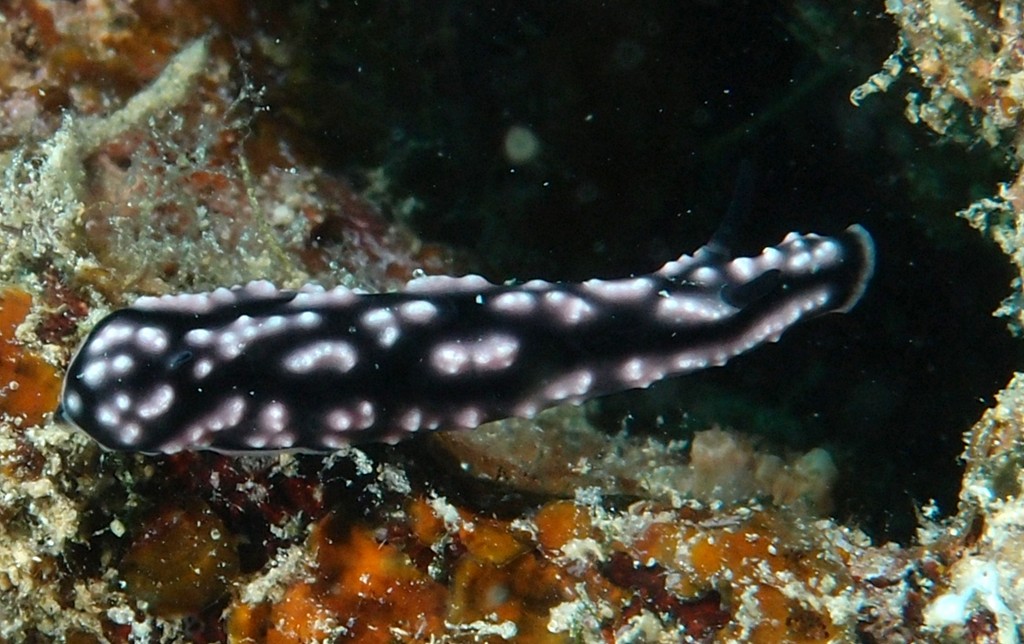PHYLLIDIOPSIS BURNI - (BRUNCKHORST, 1993)
Opisthobranchia (Infraclass) > Nudibranchia (Order) > Euctenidiacea (Suborder) > Doridacea (Infraorder) > Phyllidioidea (Superfamily) > Phyllidiidae (Family) > Phyllidiopsis (Genus)
Phyllidiopsis burni est une espèce de nudibranche de la famille des Phyllidies.
Description
Cette espèce peut mesurer jusqu'à 7 cm. Le corps est allongé et limaciforme. Le manteau a une teinte de fond noire, la surface du corps est garnie d'agglomérats de petits tubercules rosâtres de forme plutôt longitudinale. Les rhinophores sont lamellés,rétractiles et de teinte noire. Le dessous du pied est gris avec en bordure périphérique un liseré rosâtre.
Biotope
Son habitat correspond à la zone récifale externes ainsi que sur les platiers jusqu'à 30 m de profondeur. Cette Phyllidie est benthique et diurne.
Alimentation
Phyllidiopsis burni se nourrit exclusivement d'éponges.
Distribution
Cette espèce se rencontre dans la zone tropicale Ouest-Pacifique. Présente en Nouvelle-Calédonie
-------------------------------------------
Decription
Characteristic external features of Phyllidiopsis burni include: the tapering of the body anteriorly and posteriorly; deep pink, acute, multicompound tubercles (oblong in shape medially); smooth, translucent pink mantle edge; black rhinophores with 17-20 lamellae on the clavus (specimens greater than 32 mm); dark grey to black gills; grey foot with pink edge; and large, oval, oral tentacles with deep, long, dark grey lateral grooves.
Similar species
The black background coloration of the dorsum, deep pink tubercles, black rhinophores (and fewer lamellae to the rhinophoral clavus) of the present species distinguish it from Phyllidiopsis pipeki and Phyllidiopsis krempfi (both possess a pink background and pink and black rhinophores). Phyllidiopsis fissuratus is closer to the present species, but it differs in having very tall, pale pink tubercles with deep, black lined valleys. It has pink rhinophores with a black posterior stripe and 29-32 lamellae on the rhinophoral clavus. Phyllidiopsis fissuratus also has translucent pink rims to the rhinophoral pockets and a very tall, smooth, translucent pink anal papilla (both absent in Phyllidiopsis burni), and uniformly pink, square shaped oral tentacles (oval with dark grey lateral grooves in Phyllidiopsis burni).
Phyllidiopsis burni est une espèce de nudibranche de la famille des Phyllidies.
Description
Cette espèce peut mesurer jusqu'à 7 cm. Le corps est allongé et limaciforme. Le manteau a une teinte de fond noire, la surface du corps est garnie d'agglomérats de petits tubercules rosâtres de forme plutôt longitudinale. Les rhinophores sont lamellés,rétractiles et de teinte noire. Le dessous du pied est gris avec en bordure périphérique un liseré rosâtre.
Biotope
Son habitat correspond à la zone récifale externes ainsi que sur les platiers jusqu'à 30 m de profondeur. Cette Phyllidie est benthique et diurne.
Alimentation
Phyllidiopsis burni se nourrit exclusivement d'éponges.
Distribution
Cette espèce se rencontre dans la zone tropicale Ouest-Pacifique. Présente en Nouvelle-Calédonie
-------------------------------------------
Decription
Characteristic external features of Phyllidiopsis burni include: the tapering of the body anteriorly and posteriorly; deep pink, acute, multicompound tubercles (oblong in shape medially); smooth, translucent pink mantle edge; black rhinophores with 17-20 lamellae on the clavus (specimens greater than 32 mm); dark grey to black gills; grey foot with pink edge; and large, oval, oral tentacles with deep, long, dark grey lateral grooves.
Similar species
The black background coloration of the dorsum, deep pink tubercles, black rhinophores (and fewer lamellae to the rhinophoral clavus) of the present species distinguish it from Phyllidiopsis pipeki and Phyllidiopsis krempfi (both possess a pink background and pink and black rhinophores). Phyllidiopsis fissuratus is closer to the present species, but it differs in having very tall, pale pink tubercles with deep, black lined valleys. It has pink rhinophores with a black posterior stripe and 29-32 lamellae on the rhinophoral clavus. Phyllidiopsis fissuratus also has translucent pink rims to the rhinophoral pockets and a very tall, smooth, translucent pink anal papilla (both absent in Phyllidiopsis burni), and uniformly pink, square shaped oral tentacles (oval with dark grey lateral grooves in Phyllidiopsis burni).
